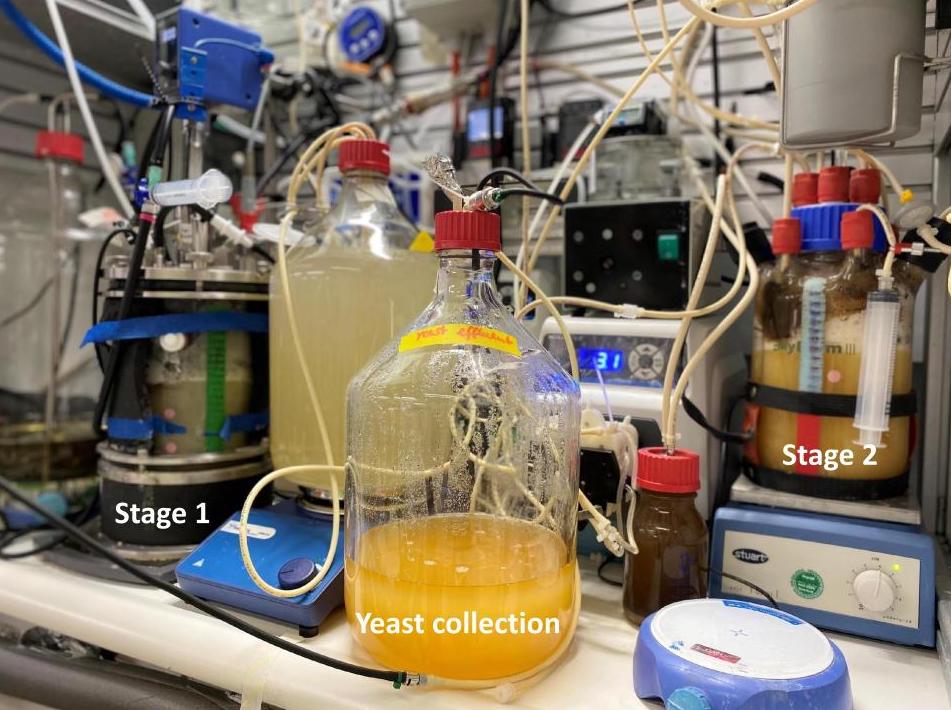How researchers are turning carbon dioxide into protein and vitamins
Similar process to brewing beer can create yeast from CO2 with more protein in a serving than beef, pork or lentils

Researchers in Germany have developed a method to turn carbon dioxide into protein and vitamin B9 using microbes, hydrogen, oxygen, and renewable energy.
The technique, reported in the journal Trends in Biotechnology on Thursday, seeks to offer an alternative to traditional farming, which is under pressure from increasing population and extreme weather events.
“This is a fermentation process similar to brewing beer but instead of giving the microbes sugar, we gave them gas and acetate,” said Largus Angenent from the University of Tübingen.
“We knew that yeast could produce vitamin B9 on their own with sugar, however, we didn’t know if they could do the same with acetate.”
The process relies on two different microbes working together in a system to produce both protein and folate, or vitamin B9, an essential nutrient for cell growth and metabolism.
In the first stage, a bacterium called Thermoanaerobacter kivui turns CO2 and hydrogen into acetate, a substance found in vinegar.
In the second stage, Saccharomyces cerevisiae, also known as baker’s yeast, is fed this acetate and oxygen. The end product of this process is a form of yeast that is edible and rich in both protein and vitamin B9.
Yeast fed with acetate produces as much vitamin B9 as yeast fed with sugar. Just six grams of yeast can meet a person’s daily vitamin B9 requirement, researchers said.
The hydrogen and oxygen needed come from splitting water using renewable energy like wind power.
“This method could take food production away from farming and offer a sustainable way to make protein,” said Mr Angenent.
Since the process uses renewable energy and CO2, it eliminates the need for farmland, providing a promising solution to food security without causing further environmental damage.
The yeast produced in this system is rich in protein. In fact, an 85-gram serving of yeast can meet 61 per cent of a person’s daily protein needs, much more than an equivalent amount of beef, pork or lentils.
There is a catch, however: untreated yeast contains compounds that can raise the risk of gout if eaten in large amounts. After treatment, the yeast still provides 41 per cent of daily protein needs, making it comparable to traditional sources of protein.
This system addresses two pressing global issues — food shortages and environmental damage. By turning CO2 into food and using renewable energy, it cuts down on carbon emissions and reduces the need for farmland.
In the past year, international agencies have continued to sound an alarm over rising food insecurity that is plunging millions of people into extreme hunger and malnutrition.
The UN World Food Program has called it “a hunger crisis of unprecedented proportions”.
Namibia, where nearly half of the population is forecast to experience food insecurity in the coming months following a drought, recently announced a plan to kill 83 elephants and 640 other wild animals to feed the people.
"We are approaching 10 billion people in the world and producing enough food will become harder," said Mr Angenent.
The yeast could also be valuable in regions facing food shortages, researchers suggested, or in countries where land and water resources are limited.
However, researchers said more work is needed before the system can be used widely. The next steps include scaling up the process, ensuring the yeast is safe for food consumption, and testing whether there is interest from the market.
“There’s still a lot to do before this yeast will be available in stores,” said Mr Angenent.
The Independent will be revealing its Climate100 List in September and hosting an event in New York, which can be attended online.
Join our commenting forum
Join thought-provoking conversations, follow other Independent readers and see their replies
Comments
Bookmark popover
Removed from bookmarks